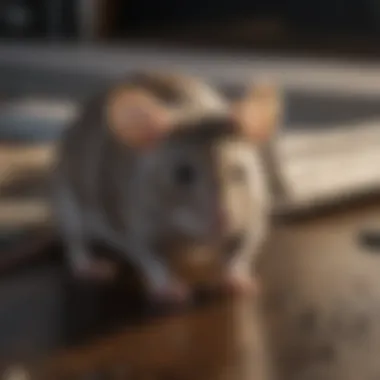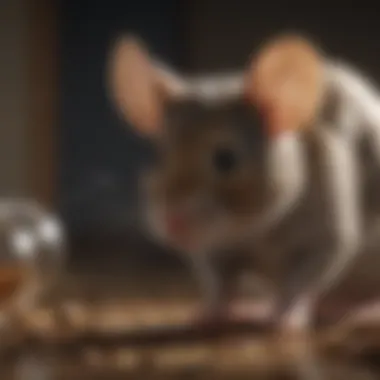How to Effectively Block Mouse Entry Points


Intro
Understanding the Pest
Identification
Recognizing a mouse infestation involves looking for specific signs. Mice are typically brown or gray and about three to ten inches long, not including their tails. Common indicators of their presence include droppings, gnaw marks on furniture or cables, and nesting materials like shredded paper or fabric. Observing these signs early can help mitigate the problem before it escalates.
Life Cycle
Mice reproduce rapidly. A female mouse can have several litters each year, with each containing about five to six young. Understanding their life cycle is important. Young mice reach maturity in six to ten weeks. This gives them plenty of time to establish a colony if not dealt with promptly. Their short lifespan and fast reproduction underscore the importance of early intervention in preventing infestations.
Pest Prevention Strategies
Environment Modification
Making environmental changes can deter mice. Keep food stored in sealed containers. Clean crumbs and spills promptly. Also, reduce clutter both inside and outside your home, as this can create cozy hiding spots. Regular landscaping maintenance can eliminate shelters near your home perimeter.
Physical Barriers
Blocking entry points is essential. Inspect your home for holes and cracks, especially around the foundation, windows, and doors. Suitable materials include steel wool, caulk, and hardware cloth. Use these materials to seal any observed openings. Pay particular attention to the areas where pipes and wires enter the house, as these are common access points.
Control Methods
Chemical Control
While blocking entry points is effective, sometimes chemical controls are needed. There are various traps and bait stations available, but use them cautiously. Always follow the manufacturer’s guidelines for safety. Make sure to position traps away from pets and children and try to use eco-friendly options whenever possible.
Biological Control
Another method involves using natural predators. Cats are known for hunting mice. However, relying solely on pets is often not effective as a long-term solution. Instead, integrate this strategy with physical barriers and environmental modifications for a comprehensive approach to pest management.
"Prevention is better than cure. Understanding mouse behavior can significantly help in keeping your home safe."
In summary, blocking mouse entry points involves a multi-faceted approach. Being proactive and using a combination of strategies can safeguard your living spaces from these persistent pests. Engaging in regular inspections and maintenance will ensure that your defensive measures remain effective.
Understanding Mouse Behavior
Understanding mouse behavior is critical in effectively blocking entry points in your home. Mice are adaptive creatures, known for their ability to exploit even the smallest vulnerabilities. By comprehending their behavior, homeowners can better anticipate potential problems and take proactive steps in prevention.
Mice seek shelter, food, and a suitable nesting area. Recognizing their motivations allows homeowners to identify effective locations to block. Furthermore, understanding the activity patterns of mice can lead to more strategic actions such as when and how to apply sealing techniques.
The Purpose of Entry Points
Mice typically enter structures through small openings. Their bodies are flexible, enabling them to squeeze through gaps as small as a quarter of an inch. Entry points serve as pathways for them to access food and nesting spots. The primary purpose of these entry points is to facilitate movement between their outdoor environment and indoor habitat. Blocking these entry points is essential in maintaining a humane and effective pest management system.
Homeowners must be vigilant. Even a tiny hole can serve as an entry point if it leads into a space with warmth and resources. Insulating materials and spaces that are sheltered from the elements are especially attractive to mice seeking refuge.
Common Attraction Factors
Several factors draw mice into homes. Food is the most significant attraction. Unsealed food containers, trash bins, or crumbs left on counters can entice mice to investigate.
Other significant attraction factors include:
- Shelter: Basements, attics, and garages can provide hiding spaces.
- Water sources: Leaky pipes or plumbing fixtures attract mice looking for hydration.
- Odors: Strong smells from food prep areas can guide mice towards a source of easy meals.
Understanding these factors aids in reducing attractions. Homeowners can minimize possible sources that may lure mice in, contributing to a more hostile environment against pests.
Mouse Nesting Preferences
Mice prefer to nest in quiet, undisturbed areas. They are likely to choose insulation materials, cardboard boxes, or cluttered areas as nesting sites. Their choice of location is often dictated by safety and proximity to food.


Key nesting preferences include:
- Warmth: Mice seek out warm areas in homes, particularly during colder months.
- Safety from predators: Areas such as behind appliances, within wall voids, or under floors provide refuge.
- Access to resources: Nesting in places that offer easy access to food sources helps sustain their populations.
Overall, understanding these nesting preferences enables homeowners to create a less inviting habitat by organizing spaces and sealing potential nesting sites.
Identifying Vulnerability Areas
Identifying vulnerability areas is a crucial aspect of preventing mouse entry into homes. This step ensures that you can effectively address potential entry points before they become a problem. Mice are known for their ability to find small openings through which they can gain access to safe havens. By knowing where to look and how to assess the situation, homeowners can take proactive measures to fortify their living environments against these intruders.
External Inspection Techniques
Conducting a thorough external inspection is the first line of defense. Begin by examining the perimeter of your home. Pay particular attention to the foundation and any gaps or cracks that may be present. Mice can squeeze through openings even smaller than a dime.
Use a flashlight to illuminate dim areas, making it easier to spot cracks or holes. Don't forget to check around doors and windows, as these are common entry points. Consider the installation of door sweeps where necessary. Ensuring that they fit snugly against the floor can help significantly reduce potential entry.
Typical Entry Points Around Structures
Mice typically enter structures through several key areas. These include:
- Cracks in the foundation: Foundation cracks can provide easy access.
- Openings around pipes and utility lines: Any cables or pipes that enter the home can create gaps that need to be sealed.
- Vents: Unsecured vents, especially those that lead into the attic or basement, should be safely covered or protected.
- Garages and sheds: These areas often have less attention and can be ignored, making them ideal for rodent entry.
Identifying these entry points is essential because they are often overlooked during standard maintenance routines.
Signs of Mouse Activity
Recognizing signs of mouse activity can also help identify vulnerable areas. Homeowners should look for:
- Droppings: Small, dark droppings can indicate recent activity, especially near food sources or entry points.
- Gnaw marks: Mice gnaw on various materials to maintain their teeth. Look for bite marks on food packaging, wood, or electrical wires.
- Nesting materials: Shredded paper, fabric, or dried plant material in hidden locations can signal nesting.
- Scratching noises: Sounds in the walls or ceilings, particularly at night, can suggest that mice are present.
"A proactive approach to identifying vulnerability areas can save homeowners from extensive damage and infestation later."
Material Selection for Blocking Entry Points
In the process of preventing mouse infestations, one critical aspect is the material selection for blocking entry points. Choosing the right materials can make a significant difference in your overall success. Not only does this contribute to a reliable barrier against invasion, but it also ensures that any effort put forth in sealing potential entry points is long-lasting and effective.
Effective blocking material should have certain characteristics. It should withstand various environmental conditions and be strong enough to deter mice from gnawing or squeezing through. Selecting materials that are not only robust but also align with the aesthetic of your home is also important. This balance between function and form can help maintain the integrity of your living space while protecting from unwanted guests.
Types of Sealing Materials
There are several types of sealing materials available, each with its own unique properties and applications. Some of the most common options include:
- Steel wool: This material is popular due to its durability and resistance to chewing. Mice tend to avoid gnawing through it.
- Caulk: Silicone caulk is flexible and fills in gaps effectively. It adheres to many surfaces, making it ideal for smaller cracks and holes.
- Expandable foam: Foam can fill large gaps quickly and expands to position itself tightly.
- Wire mesh: In areas where larger openings exist, using wire mesh can construct a physical barrier that mice cannot penetrate.
Carefully assess the nature of each entry point to determine the most suitable material. For instance, steel wool may be more effective in high-traffic areas, while caulk may suffice for small cracks.
Durability and Effectiveness of Materials
When selecting materials, durability plays a vital part in long-term effectiveness. You want to choose materials that can withstand weather changes and do not degrade quickly. For example, silicone caulk holds well against moisture, while expandable foam can become soggy over time if used in the wrong location.
Furthermore, some materials may require periodic reapplication or inspection. For example, physical barriers such as wire mesh may need to be checked regularly to ensure no weaknesses have developed. Regular monitoring helps maintain their integrity and function.
Eco-friendly Alternatives
For housewives and homeowners who prefer eco-friendly alternatives, there are various options that do not harm the environment.
- Natural sealants: Some sealants made from organic materials provide an effective barrier against pests while being safe for indoor use.
- Recycled materials: Using recycled or upcycled products can be a sustainable option if they meet durability standards.
- Essential oils: Mice are known to dislike the scent of certain essential oils, such as peppermint or eucalyptus. While these alone won’t seal entry points, combining them with physical barriers can enhance effectiveness.
By opting for these alternatives, one can combat mouse issues without compromising environmental values.
In summary, carefully selected materials are essential in blocking mouse entry points. Mice will always seek vulnerabilities, so robust and reliable materials will help safeguard your home effectively.


Step-by-Step Process to Block Entry Points
Blocking mouse entry points is essential for a secure and pest-free home. An effective step-by-step process can help you systematically identify and address vulnerabilities. Following a structured method not only brings clarity but also increases the potential for success in preventing mouse infestations.
Conducting a Thorough Assessment
The first step in the process involves conducting a thorough assessment of your property. This means examining both the interior and exterior of your home. Look for small openings, cracked walls, and gaps around pipes or vents. You should also check for any damaged screens on windows. The goal is to create a detailed list of potential entry points that need attention.
- Pay special attention to areas like basements, attics, and garages, as these locations often harbor unnoticed gaps.
- Use a flashlight if necessary, as proper lighting can reveal holes that may be shadows otherwise.
Preparing the Area
Once you have identified the potential entry points, the next step is to prepare the area. Remove any obstructions like furniture or tools around these spots. This will provide a clear workspace and ensure that you can work efficiently. Keeping the workspace tidy is important so that items won’t get in the way during sealing.
- Have your tools and materials at hand. This should include the sealing materials, a caulking gun, gloves, and protective eyewear.
- Make sure you understand the types of materials you are using for sealing, so that you apply the correct method.
Sealing Techniques and Application
With your area prepared, it's time to seal the entry points using appropriate techniques.
- Caulking: This is best for small gaps and cracks. Apply a bead of caulk and smooth it out with a finger or tool for a clean finish.
- Mesh Wire: For larger openings, consider using mesh wire. This material is useful for preventing mice from squeezing through.
- Expanding Foam: This can fill larger voids effectively, but it expands significantly, so apply sparingly.
Make sure to closely follow the manufacturer's instructions for each sealing material to maximize effectiveness.
Inspecting the Sealed Points
Once you finish sealing all identified points, take time to inspect your work. This means checking the seals for completeness and ensuring that everything is applied properly. Look for any areas that may have been missed or are not secure.
- Monitor the sealed areas over the next few days for any signs of mouse activity. Look for droppings, gnaw marks, or nesting material nearby.
- If you notice any weaknesses, address them immediately. Reapply or add more material as needed to reinforce protection.
"Sealing entry points is the first line of defense against mice. Consistency in inspection and maintenance will aid in long-term effectiveness."
Through this step-by-step process, you can significantly reduce the chances of mice invading your living space. By combining assessment, preparation, sealing, and inspection, you create a comprehensive strategy that enhances your home's defenses.
Maintenance and Regular Inspections
Maintaining and regularly inspecting blocked entry points is not just a routine task; it is a crucial aspect of effective pest management. Once the initial barriers are in place, their effectiveness must be periodically evaluated. This ensures that the mouse-proofing measures remain intact and functional over time.
Benefits of Routine Maintenance
Conducting scheduled checks for vulnerabilities allows homeowners to identify any new openings or weaknesses that might have developed. Weather changes, construction work, or even simply the passage of time can affect the integrity of sealing materials. Mice are persistent creatures, and they can exploit even the smallest gaps. Regular inspections help to minimize this risk.
Additionally, routine maintenance can save costs in the long run. Addressing minor problems before they escalate into significant infestations is far more economical than dealing with a full-blown mouse problem later. Implementing a maintenance schedule helps keep the home environment secure and comfortable.
Scheduled Checks for Vulnerabilities
Scheduled checks are best carried out every few months, as a general rule. However, this frequency may vary depending on the surroundings and season. In particular, after heavy storms or significant weather events, a dedicated inspection is advisable. Look for signs of wear around sealed points. A notable lapse in the integrity of any seals, such as loose caulk or damaged screens, should be addressed immediately.
During an inspection, some specific areas to focus on include:
- Foundation Cracks: Small gaps can appear over time, so it’s vital to check for new developments.
- Pet Door Seals: These flexible seals may wear out and need replacement.
- Window Screens: Ensure that screens are in good condition without holes.
- Vents: Check that all ventilation openings are secured.
These checks culminate in identifying any new risks that could allow mice to enter, allowing for swift remedial actions.
Signs to Monitor Post-Blocking
After blocking off potential entry points, homeowners should remain vigilant for signs suggesting that mice may still be attempting to enter or have entered the premises. While the goal is to prevent rodent access, understanding and recognizing these signs is essential. Common indicators include:
- Gnaw Marks: Fresh marks around sealed areas could indicate that mice are trying to gain access.
- Droppings: Droppings typically signal recent mouse activity. If found near sealed points, it might suggest inadequate sealing.
- Noises: Hearing scratching or scurrying sounds in walls or ceilings may indicate ongoing mouse activity.
- Nests: Discovering nests made from shredded materials could mean that mice have gained shelter in the home despite efforts to block entry.
Regular checks and attentive monitoring can make the difference between a mouse-free home and an established infestation.
Staying proactive with maintenance and inspections will help ensure that your efforts in blocking mouse entry points are successful over time.


Understanding Alternative Prevention Strategies
In the quest to effectively block entry points for mice, consideration of alternative prevention strategies is vital. While sealing physical gaps serves as the primary defense, integrating complementary strategies not only enhances safety but also mitigates risks associated with pest infestations. These additional methods emphasize creating an environment that discourages mouse activities, thus facilitating long-term success.
Environmental Modifications
Environmental modifications present practical and proactive solutions to deter mice. By adjusting the surroundings, homeowners can significantly reduce the factors that attract mice. Key points include:
- Decluttering: Keeping spaces organized not only makes inspections easier but also removes potential nesting sites.
- Proper Storage: Use airtight containers to store food and minimize spillage. This significantly decreases the likelihood of attracting rodents.
- Yard Maintenance: Maintain the landscape by trimming overgrown vegetation and removing debris. This reduces the natural habitats that mice might use nearby your home.
- Trash Management: Secure garbage in tightly sealed bins. Mice are drawn to easy food sources, and proper disposal practices can mitigate their attraction.
Implementing these strategies requires a mindful approach to everyday living, reinforcing the idea that a clean and well-maintained environment is crucial in the fight against pests.
Use of Natural Deterrents
Incorporating natural deterrents represents an eco-friendly method to repel mice without harsh chemicals. Many homeowners seek non-toxic solutions that are safe for families and pets while maintaining effectiveness. Here are some popular natural deterrents:
- Peppermint Oil: Scientifically, it has been recognized for its ability to repel mice. Placing cotton balls soaked in peppermint oil near entry points can create a barrier mice tend to avoid.
- Ultrasonic Devices: These devices emit high-frequency sounds that are irritating to pests but undetectable to humans. They can create discomfort for mice, discouraging them from invading your space.
- Natural Predators: Encouraging natural predators such as owls or cats can help reduce mouse populations. This method utilizes the local ecosystem to manage pests without direct intervention.
- Cayenne Pepper: Sprinkling cayenne pepper in areas where you've noticed activity can deter mice. The strong smell is unappealing to them and can act as a natural barrier.
Natural deterrents, while effective, should be combined with physical sealing methods for optimal results. By employing these strategies, homeowners not only protect their properties but also contribute to a more sustainable approach in pest management.
"Implementing these alternative strategies not only protects homes but also supports environmental consciousness."
Maintaining an atmosphere that discourages mouse nesting and activity is just as necessary as blocking physical entry points. Engaging in both sealing and alternative strategies provides a comprehensive solution to ensure pests are kept at bay.
Choosing Professional Help
Engaging professionals for pest control can be a decisive step in effective mouse management. While some homeowners may feel equipped to tackle the problem themselves, sometimes the experience and specialized skills of pest control experts can make a significant difference. This section covers when to consult professionals and how to evaluate their services, ensuring you make an informed choice.
When to Consult Pest Control Experts
Recognizing the right moment to seek professional help is critical for homeowners. One may contemplate hiring a pest control expert when:
- Persistent Infestation: If you notice that mice are repeatedly entering your property despite your efforts to seal openings, it may be time to consult a professional.
- Health Concerns: Mice can carry diseases. If you have vulnerable individuals in your home, such as children or elderly family members, it's wise to get expert assistance.
- Extensive Damage: If you suspect that the mice might be causing significant damage to the structure or wiring in your home, a professional should be involved to assess the risks thoroughly.
- Lack of Time or Resources: Not all homeowners have the time or expertise necessary to deal with infestations. If a situation demands immediate attentions, a pest control service becomes essential.
Consulting pest control professionals can potentially save you time and reduce the risk of health hazards while offering an integrated approach to pest management.
Evaluating Pest Control Services
Choosing the right pest control service involves several considerations that can affect the outcome of your mouse control strategy. Here’s how to evaluate potential services:
- Reputation: Look for companies with good reviews and strong reputations. Websites like Reddit and local Facebook groups often yield candid feedback about service quality.
- Experience and Credentials: Check if the technicians are properly trained, certified, and have experience with mouse infestations specifically. An experienced professional is more likely to identify entry points and offer tailored solutions.
- Inspecting Methods Used: Inquire about the methods they use. Efficient professionals should employ not only immediate extermination methods but also long-term prevention strategies.
- Cost Transparency: A good pest control service will provide a clear outline of costs. Understand what constitutes the price you are paying to avoid hidden fees.
- Follow-Up Services: After the initial treatment, it’s important to know if the company offers follow-up services to monitor the effectiveness of the initial treatment and ensure no new entry points are established.
By taking these factors into account, homeowners can make informed decisions about engaging professional pest control services, ultimately leading to more effective management of mouse entry points.
Summary and Best Practices
In the fight against mouse infestations, understanding key measures and committing to best practices can significantly enhance effective prevention strategies. The Summary and Best Practices section serves to consolidate the informative insights shared throughout this article, presenting clear takeaways that readers can readily apply.
It is crucial to remember that blocking entry points is not merely a one-time activity but requires ongoing attention. Addressing the vulnerabilities identified around the property enhances the overall efficacy of your mouse prevention efforts. Additionally, regularly scheduled assessments of previously sealed points can help to identify any new weaknesses.
Recapping Essential Measures
A few essential measures stand out in the journey to block mouse entry effectively. Consider summarizing the following actionable points:
- Identify Entry Points: Conduct a thorough inspection of your property to pinpoint potential vulnerabilities in walls, foundations, and utility openings.
- Utilize Appropriate Materials: Invest in high-quality sealing materials, such as steel wool, caulk, or expanding foam, that have been proven to deter mouse access.
- Employ Correct Sealing Techniques: Ensure that all identified gaps are correctly sealed using the appropriate methodology, following the guidance outlined in this document.
- Maintain Clean Surroundings: Keeping the house and its surroundings clutter-free minimizes conditions that encourage mouse nesting.
These critical actions can dramatically impact the presence of mice around your home.
Long-term Strategies for Prevention
Beyond the immediate blocking of entry points, considering long-term strategies is essential for sustained effectiveness in pest management. Some strategic insights include:
- Environmental Modifications: Adjust landscaping and remove potential food sources that attract mice. This can include securing garbage bins and using rodent-proof containers for pet food.
- Regular Inspections: Schedule periodic checks after blocking measures have been implemented. This will help maintain a proactive stance in managing potential reentry risks.
- Neighborhood Awareness: Become aware of trends or issues in your neighborhood. If surrounding homes experience pest infestations, it is wise to be vigilant.
Implementing continuous preventive strategies creates an environment that is less conducive to mouse habitation and enhances the overall livability of your space.
By focusing on these long-term strategies and best practices, homeowners can cultivate a lasting defense against mice, ensuring peace of mind in their living environments.





